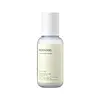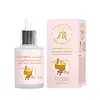What's inside
What's inside
 Key Ingredients
Key Ingredients

 Benefits
Benefits

 Concerns
Concerns

 Ingredients Side-by-side
Ingredients Side-by-side

Water
Skin ConditioningGlycerin
HumectantCetyl Ethylhexanoate
EmollientDipropylene Glycol
HumectantGalactomyces Ferment Filtrate
HumectantButylene Glycol
HumectantNiacinamide
Smoothing1,2-Hexanediol
Skin ConditioningBetaine
HumectantHydroxyacetophenone
AntioxidantPanthenol
Skin ConditioningPolyglyceryl-3 Methylglucose Distearate
EmulsifyingTrehalose
HumectantGlyceryl Stearate
EmollientCarbomer
Emulsion StabilisingArginine
MaskingSorbitan Stearate
EmulsifyingXanthan Gum
EmulsifyingSorbitan Sesquioleate
EmulsifyingEthylhexylglycerin
Skin ConditioningAdenosine
Skin ConditioningButyrospermum Parkii Butter
Skin ConditioningDisodium EDTA
Caprylic/Capric Triglyceride
MaskingLactobacillus/Soybean Ferment Extract
Skin ConditioningLactobacillus/Rice Ferment
Skin ConditioningLactobacillus/Panax Ginseng Root Extract Ferment Filtrate
Skin ConditioningSaccharomyces/Coix Lacryma-Jobi Ma-Yuen Seed Ferment Filtrate
Skin ConditioningSaccharomyces/Potato Extract Ferment Filtrate
HumectantSucrose Cocoate
EmulsifyingCeramide NP
Skin ConditioningHydrogenated Lecithin
EmulsifyingPhytosphingosine
Skin ConditioningCholesterol
EmollientHydrolyzed Soy Protein
HumectantPhytosterols
Skin ConditioningMentha Suaveolens Leaf Extract
AstringentCamellia Sinensis Leaf Extract
AntimicrobialThymus Vulgaris Leaf Extract
Skin ProtectingSoluble Collagen
HumectantGlucose
HumectantMannose
HumectantGlutathione
Oligopeptide-29
AntioxidantOligopeptide-32
AntiseborrhoeicPalmitoyl Pentapeptide-4
Skin ConditioningWater, Glycerin, Cetyl Ethylhexanoate, Dipropylene Glycol, Galactomyces Ferment Filtrate, Butylene Glycol, Niacinamide, 1,2-Hexanediol, Betaine, Hydroxyacetophenone, Panthenol, Polyglyceryl-3 Methylglucose Distearate, Trehalose, Glyceryl Stearate, Carbomer, Arginine, Sorbitan Stearate, Xanthan Gum, Sorbitan Sesquioleate, Ethylhexylglycerin, Adenosine, Butyrospermum Parkii Butter, Disodium EDTA, Caprylic/Capric Triglyceride, Lactobacillus/Soybean Ferment Extract, Lactobacillus/Rice Ferment, Lactobacillus/Panax Ginseng Root Extract Ferment Filtrate, Saccharomyces/Coix Lacryma-Jobi Ma-Yuen Seed Ferment Filtrate, Saccharomyces/Potato Extract Ferment Filtrate, Sucrose Cocoate, Ceramide NP, Hydrogenated Lecithin, Phytosphingosine, Cholesterol, Hydrolyzed Soy Protein, Phytosterols, Mentha Suaveolens Leaf Extract, Camellia Sinensis Leaf Extract, Thymus Vulgaris Leaf Extract, Soluble Collagen, Glucose, Mannose, Glutathione, Oligopeptide-29, Oligopeptide-32, Palmitoyl Pentapeptide-4
Oryza Sativa Bran Water
MaskingAvena Sativa Kernel Extract
AbrasiveSqualane
EmollientPropanediol
SolventGlycerin
HumectantDimethyl Sulfone
SolventCaprylic/Capric Triglyceride
MaskingWater
Skin ConditioningButylene Glycol
HumectantAvena Sativa Kernel Oil
Skin ConditioningLinum Usitatissimum Seed Oil
PerfumingCentella Asiatica Extract
CleansingGlycine Max Oil
EmollientPanthenol
Skin ConditioningBetaine
HumectantPolyglyceryl-6 Stearate
EmollientGlyceryl Stearate
EmollientCorylus Avellana Seed Oil
EmollientCetearyl Alcohol
EmollientCeramide Ng
Skin ConditioningHelianthus Annuus Seed Oil
EmollientCamellia Sinensis Leaf Extract
AntimicrobialRosmarinus Officinalis Leaf Extract
AntimicrobialChamomilla Recutita Flower Extract
MaskingArginine
MaskingTocopheryl Acetate
AntioxidantCetyl Palmitate
EmollientSorbitan Palmitate
EmulsifyingCaprylyl Glycol
EmollientScutellaria Baicalensis Root Extract
AstringentGlycyrrhiza Glabra Root Extract
BleachingCaprylhydroxamic Acid
Zanthoxylum Piperitum Fruit Extract
Skin ConditioningPolyglyceryl-6 Behenate
Emulsion StabilisingCarbomer
Emulsion StabilisingPulsatilla Koreana Extract
Skin ConditioningSorbitan Olivate
EmulsifyingXanthan Gum
EmulsifyingUsnea Barbata Extract
Polygonum Cuspidatum Root Extract
AntioxidantMelaleuca Alternifolia Leaf Oil
AntioxidantCitrus Aurantium Bergamia Leaf Oil
AstringentCedrus Atlantica Bark Oil
MaskingOryza Sativa Bran Water, Avena Sativa Kernel Extract, Squalane, Propanediol, Glycerin, Dimethyl Sulfone, Caprylic/Capric Triglyceride, Water, Butylene Glycol, Avena Sativa Kernel Oil, Linum Usitatissimum Seed Oil, Centella Asiatica Extract, Glycine Max Oil, Panthenol, Betaine, Polyglyceryl-6 Stearate, Glyceryl Stearate, Corylus Avellana Seed Oil, Cetearyl Alcohol, Ceramide Ng, Helianthus Annuus Seed Oil, Camellia Sinensis Leaf Extract, Rosmarinus Officinalis Leaf Extract, Chamomilla Recutita Flower Extract, Arginine, Tocopheryl Acetate, Cetyl Palmitate, Sorbitan Palmitate, Caprylyl Glycol, Scutellaria Baicalensis Root Extract, Glycyrrhiza Glabra Root Extract, Caprylhydroxamic Acid, Zanthoxylum Piperitum Fruit Extract, Polyglyceryl-6 Behenate, Carbomer, Pulsatilla Koreana Extract, Sorbitan Olivate, Xanthan Gum, Usnea Barbata Extract, Polygonum Cuspidatum Root Extract, Melaleuca Alternifolia Leaf Oil, Citrus Aurantium Bergamia Leaf Oil, Cedrus Atlantica Bark Oil
 Reviews
Reviews

Alternatives
Ingredients Explained
These ingredients are found in both products.
Ingredients higher up in an ingredient list are typically present in a larger amount.
Arginine is an amino acid that is important for human development. Your body uses is it to produce hair keratin and skin collagen.
As a cosmetic ingredient, Arginine has antioxidant properties and can also help repair damaged skin. This ingredient is derived either synthetically or from animals.
Arginine isn't fungal acne safe when used in the presence of other lipids (fats, fatty acids, oils, esters, etc). Oils and fats occur naturally within the skin, so take caution when using Arginine if you're prone to fungal acne.
Learn more about ArginineBetaine is a common humectant (a substance that promotes retention of moisture). It's known to be gentle on the skin and can help balance hydration.
This ingredient is best for improving hydration and soothing irritated skin. Studies also show it helps even out skin tone.
Fun fact: Betaine is naturally created in the skin and body. The kind found within cosmetic products can be either plant-derived or synthetic.
Another name for betaine is trimethylglycine.
Learn more about BetaineButylene Glycol (or BG) is used within cosmetic products for a few different reasons:
Overall, Butylene Glycol is a safe and well-rounded ingredient that works well with other ingredients.
Though this ingredient works well with most skin types, some people with sensitive skin may experience a reaction such as allergic rashes, closed comedones, or itchiness.
Learn more about Butylene GlycolCamellia Sinensis Leaf Extract is derived from the leaves of the tea plant. Black tea, green tea, and oolong tea are all harvested from this plant.
This ingredient has many skin benefits:
This ingredient contains polyphenols, a strong antioxidant. Antioxidants help fight off molecules that damage skin cells.
On top of that, the antioxidants in green tea neutralize free-radicals from the sun. This gives the skin some extra UV protection, but should not replace sunscreen.
Many components of tea have anti-inflammatory properties.
Polyphenols and L-theanine help soothe the skin and reduce irritation. The caffeine in Camellia Sinensis Leaf Extract helps calm inflamed blood vessels.
Other compounds found in tea include: Vitamin Bs, linoleic acid, magnesium, calcium, iron, and zinc.
Research has shown both drinking Camellia Sinensis Leaf Tea and applying it to the skin can help boost skin elasticity and hydration. Studies also show using tea extract may reduce sebum, or oil, production.
Learn more about Camellia Sinensis Leaf ExtractThis ingredient is an emollient, solvent, and texture enhancer. It is considered a skin-softener by helping the skin prevent moisture loss.
It helps thicken a product's formula and makes it easier to spread by dissolving clumping compounds.
Caprylic Triglyceride is made by combining glycerin with coconut oil, forming a clear liquid.
While there is an assumption Caprylic Triglyceride can clog pores due to it being derived from coconut oil, there is no research supporting this.
Learn more about Caprylic/Capric TriglycerideCarbomer is a polymer of acrylic acid. Its main role is to create a gel consistency.
A high amount of carbomer can cause pilling or balling up of products. Don't worry, most products contain 1% or less of carbomer.
Glycerin is already naturally found in your skin. It helps moisturize and protect your skin.
A study from 2016 found glycerin to be more effective as a humectant than AHAs and hyaluronic acid.
As a humectant, it helps the skin stay hydrated by pulling moisture to your skin. The low molecular weight of glycerin allows it to pull moisture into the deeper layers of your skin.
Hydrated skin improves your skin barrier; Your skin barrier helps protect against irritants and bacteria.
Glycerin has also been found to have antimicrobial and antiviral properties. Due to these properties, glycerin is often used in wound and burn treatments.
In cosmetics, glycerin is usually derived from plants such as soybean or palm. However, it can also be sourced from animals, such as tallow or animal fat.
This ingredient is organic, colorless, odorless, and non-toxic.
Glycerin is the name for this ingredient in American English. British English uses Glycerol/Glycerine.
Learn more about GlycerinGlyceryl Stearate is a mix of glycerin and stearic acid.
It is used to stabilize the mixing of water and oil ingredients. By preventing these ingredients from separating, it can help elongate shelf life. It can also help thicken the product's texture.
As an emollient, it helps soften skin and supports barrier-replenishing ingredients.
In cosmetics, Glyceryl Stearate is often made from vegetable oils or synthetically produced.
This ingredient may not be fungal-acne safe
Fun fact: The human body also creates Glyceryl Stearate naturally.
Learn more about Glyceryl StearatePanthenol is a common ingredient that helps hydrate and soothe the skin. It is found naturally in our skin and hair.
There are two forms of panthenol: D and L.
D-panthenol is also known as dexpanthenol. Most cosmetics use dexpanthenol or a mixture of D and L-panthenol.
Panthenol is famous due to its ability to go deeper into the skin's layers. Using this ingredient has numerous pros (and no cons):
Like hyaluronic acid, panthenol is a humectant. Humectants are able to bind and hold large amounts of water to keep skin hydrated.
This ingredient works well for wound healing. It works by increasing tissue in the wound and helps close open wounds.
Once oxidized, panthenol converts to pantothenic acid. Panthothenic acid is found in all living cells.
This ingredient is also referred to as pro-vitamin B5.
Learn more about PanthenolWater. It's the most common cosmetic ingredient of all. You'll usually see it at the top of ingredient lists, meaning that it makes up the largest part of the product.
So why is it so popular? Water most often acts as a solvent - this means that it helps dissolve other ingredients into the formulation.
You'll also recognize water as that liquid we all need to stay alive. If you see this, drink a glass of water. Stay hydrated!
Learn more about WaterXanthan gum is used as a stabilizer and thickener within cosmetic products. It helps give products a sticky, thick feeling - preventing them from being too runny.
On the technical side of things, xanthan gum is a polysaccharide - a combination consisting of multiple sugar molecules bonded together.
Xanthan gum is a pretty common and great ingredient. It is a natural, non-toxic, non-irritating ingredient that is also commonly used in food products.
Learn more about Xanthan Gum